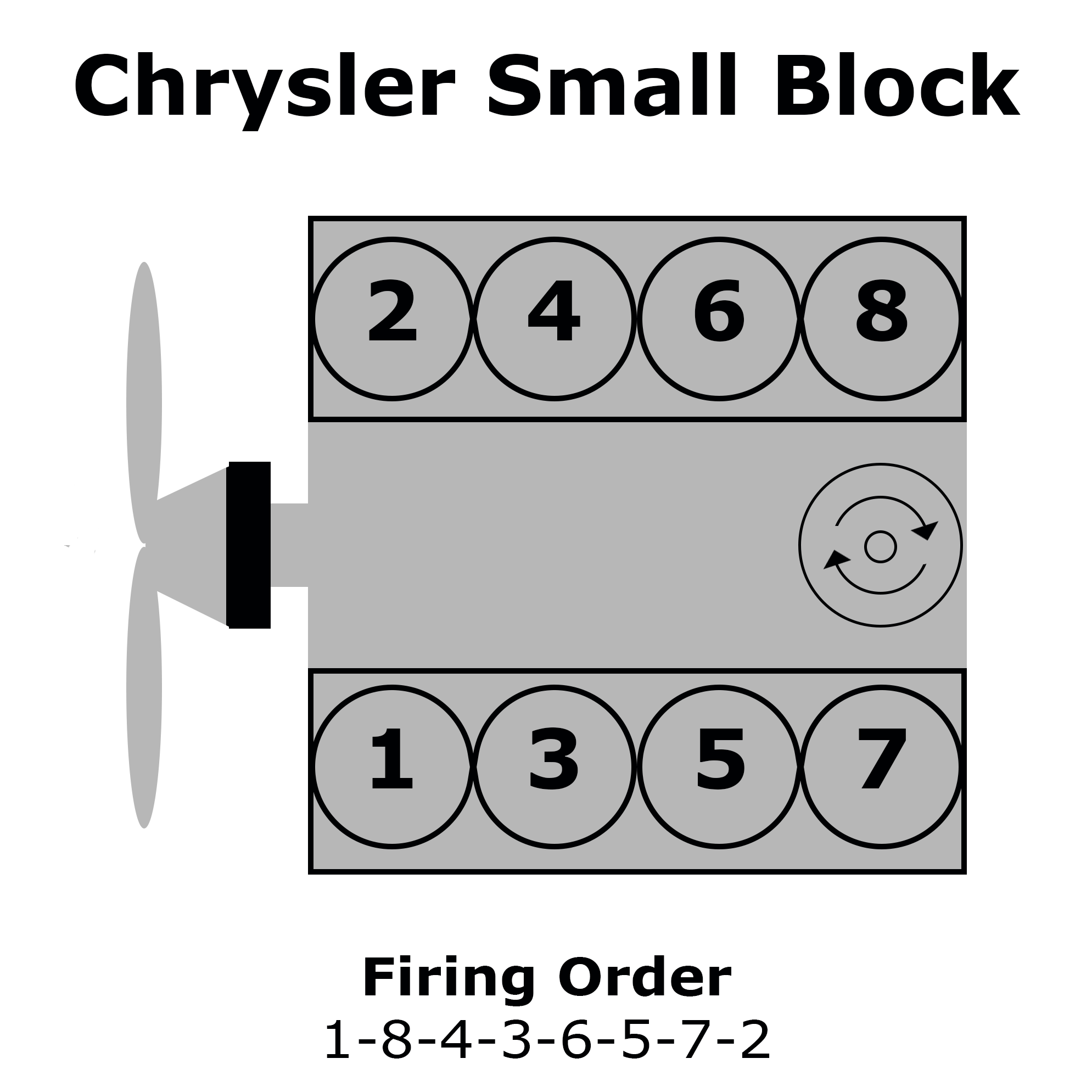The Mopar 318 engine, part of Chrysler’s small-block LA-series V8 family, is a legendary powerplant known for its reliability, efficiency, and versatility. Widely used in vehicles like Dodge Chargers, Plymouth Barracudas, and Chrysler trucks, the Mopar 318 depends on a precise firing order to deliver smooth and efficient performance.
This guide explores the Mopar 318 firing order, its importance, and tips for maintaining it.

Quick Navigation
What is a Firing Order?
The firing order refers to the specific sequence in which the engine’s cylinders ignite their air-fuel mixture. For the Mopar 318, the firing order is 1-8-4-3-6-5-7-2.

This carefully designed sequence ensures that power is delivered evenly, keeping the engine balanced and running smoothly. Disrupting this firing order can lead to performance issues and engine damage. Let’s explore why this sequence is so vital.
Why the Firing Order Matters
The firing order is a fundamental part of the engine’s operation. Here’s why it matters:
- Engine Balance: The firing order distributes power evenly across the engine, minimizing vibrations and ensuring stability.
- Power Delivery: A proper sequence ensures continuous torque, enabling smooth acceleration.
- Efficiency: Correct firing promotes complete combustion, improving fuel economy and reducing emissions.
- Durability: Balanced operation reduces stress on engine components, prolonging their lifespan.
- Smooth Performance: A consistent firing order prevents misfires and ensures reliable operation.
Disrupting the firing order can lead to symptoms like rough idling, reduced power, and excessive vibrations, all of which can harm the engine’s performance and longevity.
The Mopar 318 Firing Order: 1-8-4-3-6-5-7-2
The Mopar 318’s firing order follows the pattern 1-8-4-3-6-5-7-2. Let’s break this sequence down step by step:
- Cylinder 1 Fires First: The sequence begins with Cylinder 1, where the spark plug ignites the air-fuel mixture.
- Cylinder 8 Fires Next: Cylinder 8 takes over, maintaining smooth power delivery.
- Cylinder 4 Engages: Cylinder 4 fires, contributing to balanced operation.
- Cylinder 3 Ignites: Cylinder 3 follows, continuing the sequence.
- Cylinder 6 Fires: Cylinder 6 takes its turn in the firing cycle.
- Cylinder 5 Engages: Cylinder 5 fires, maintaining the rhythm of the engine.
- Cylinder 7 Fires: Cylinder 7 follows, balancing power output.
- Cylinder 2 Completes the Cycle: Finally, Cylinder 2 fires, and the sequence repeats.
This firing order ensures that the Mopar 318’s V8 engine operates efficiently, with power strokes evenly spaced to optimize performance and reduce vibrations.
How the Firing Order Works in the Mopar 318
The Mopar 318 operates on a four-stroke cycle, which consists of the following stages:
- Intake Stroke: The air-fuel mixture enters the cylinder as the intake valve opens.
- Compression Stroke: The piston compresses the mixture, preparing it for ignition.
- Power Stroke: The spark plug ignites the mixture, creating an explosion that drives the piston downward to generate power.
- Exhaust Stroke: The exhaust valve opens, releasing spent gases.
The firing order synchronizes these strokes across all eight cylinders, ensuring smooth and continuous power delivery. The 1-8-4-3-6-5-7-2 sequence evenly distributes the workload, preventing imbalances and maximizing efficiency.
Components Supporting the Firing Order
Several critical components ensure the Mopar 318’s firing order is executed correctly. These include:
- Crankshaft: Converts the pistons’ vertical motion into rotational energy and dictates the sequence of power strokes.
- Camshaft: Times the opening and closing of the intake and exhaust valves, aligning them with the firing order.
- Distributor: Routes electrical signals to the spark plugs in the correct sequence, ensuring proper ignition timing.
- Spark Plugs: Ignite the air-fuel mixture in each cylinder at the precise moment.
- Timing Chain/Belt: Synchronizes the crankshaft and camshaft, maintaining the proper firing order.
When these components function together seamlessly, the Mopar 318 delivers smooth and reliable performance.
Symptoms of Firing Order Issues
An incorrect firing order can lead to several noticeable symptoms that affect the engine’s performance. Common issues include:
- Engine Misfires: One or more cylinders fail to ignite properly, causing uneven power delivery.
- Rough Idling: The engine may vibrate excessively or run inconsistently when idling.
- Power Loss: An incorrect firing order reduces efficiency, resulting in sluggish acceleration.
- Backfiring: Faulty timing may cause combustion gases to ignite in the intake or exhaust system.
- Excessive Vibrations: Imbalanced firing creates noticeable engine vibrations.
If these symptoms occur, diagnosing and addressing the issue promptly can prevent further damage to the engine.
How to Verify the Firing Order
To ensure the Mopar 318’s firing order is correct, follow these steps:
- Check the Spark Plug Wires: Verify that each wire is connected to the correct cylinder and distributor terminal according to the firing order.
- Inspect the Distributor Cap: Ensure the cap is properly aligned and in good condition.
- Use a Timing Light: A timing light can confirm that each spark plug fires at the correct moment.
- Consult the Service Manual: For the proper wiring diagram and firing sequence, refer to the Mopar 318 service manual.
- Listen for Unusual Noises: Sputtering, knocking, or other irregular engine sounds may indicate a firing order problem.
Routine checks help maintain the firing order and ensure the engine runs smoothly.
Maintaining the Firing Order
Proper maintenance is essential to preserve the Mopar 318’s firing order and overall performance. Here are some practical tips:
- Replace Spark Plugs Regularly: Worn or fouled spark plugs can cause misfires and disrupt the firing sequence.
- Inspect Ignition Components: Check the distributor, ignition coil, and spark plug wires for wear or damage.
- Monitor the Timing Chain/Belt: Ensure the timing mechanism is properly aligned and tensioned to avoid disruptions.
- Perform Routine Tune-Ups: Regular inspections and adjustments help identify and fix firing order issues early.
- Use High-Quality Fuel: Clean-burning fuel reduces carbon buildup, promoting efficient combustion.
These maintenance practices will keep your Mopar 318 running reliably and efficiently.
Can You Modify the Firing Order?
The Mopar 318’s firing order, 1-8-4-3-6-5-7-2, is specifically designed for its V8 engine configuration. Modifying this sequence is not advisable because:
- Imbalance Issues: Changing the firing order can cause excessive vibrations and instability.
- Reduced Efficiency: An incorrect sequence disrupts combustion, resulting in power loss and increased fuel consumption.
- Potential Damage: Altering the firing order may stress engine components, leading to long-term damage.
For performance improvements, focus on upgrades like tuning the ignition system, optimizing the intake and exhaust, or enhancing the carburetor instead of altering the firing order.
Conclusion
The Mopar 318’s firing order, 1-8-4-3-6-5-7-2, is a cornerstone of its legendary V8 engine design. This precise sequence ensures balanced operation, smooth power delivery, and efficient combustion. Understanding how the firing order works and maintaining it is key to keeping your Mopar 318 engine running reliably and performing at its best.
By conducting regular maintenance, addressing firing order issues promptly, and using quality components, you can preserve the performance and longevity of your Mopar 318 engine. Whether you’re maintaining a classic car or driving a dependable daily vehicle, adhering to the correct firing order ensures you’ll enjoy the power, durability, and smooth performance that make the Mopar 318 an enduring favorite among enthusiasts.

